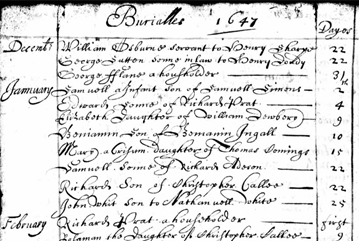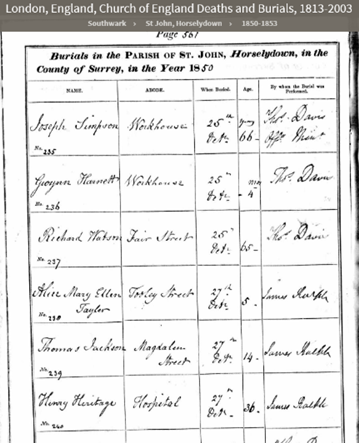A guide to searching for death and burial records in Southwark
How do you find out when a person died?
If searching for a death before 1837, when civil registration began in England and Wales, then the parish records of burials (including the nonconformist registers) will be the first port of call. These records date from around the 1600s for some of Southwark's ancient parishes and can be accessed via Ancestry and FindMyPast. (Ancestry Library Edition is free to use for members of Southwark Libraries). They do not record the date of death, but you can safely assume that this would have been a few days earlier as it was not possible to store a dead body for longer than this.


Earlier records contain little more information than the date of burial but can contain, for example in the case of an infant’s death, the parent’s name, which is useful for family history research. It is sometimes possible to see a person’s work status like in the example shown here.
Later parish records contain more information including the address of the deceased.
After 1837, the civil registration records will be the place to further establish the date of death. You can access free indexes at www.FreeBMD.org.uk (1837 to 1993) and www.familysearch.org (1837 to 2005). The following sites also hold indexes but may charge to use their site or require registration.
- www.ancestry.co.uk (free with Southwark Libraries Membership)
- www.findmypast.com
- www.bmdindex.co.uk
- www.thegenealogist.co.uk
- www.familyrelatives.org
- www.deceasedonline.com
Indexes are just that and generally do not show the date of death. They usually list the names of people who have died (sometimes they will show the date of birth), registration district, year and the quarter period in which the death was registered (e.g. Jan-Mar) and the all-important reference number which will be needed to order a death certificate, which does record the date of death.
Other sources to help establish dates for death
- Reports of coroners' inquests
- Local newspaper reports
- The Commonwealth War Graves Commission database
- Council Minutes, which often mention the death of aldermen, councillors, MPs and staff members.
- Second World War Incident Registers
- Rolls of Honour
- These Rough Notes: the Raids on Southwark (1940-1945), Compiled by John Hook. These books contain lists of fatal casualties in the Metropolitan Boroughs of Bermondsey, Camberwell and Southwark during the Second World War, along with crucial information like name, age, address, date and cause of death and other linked fatalities. Hook has also given descriptions about events around the raids and included newspaper articles where possible and extracts on the medals and awards given posthumously to brave adults and children. Each book has name indexes.
- Parish and club magazines, such as Peek Freans
With the exception of coroners' inquests, all of these can be accessed at Southwark Archives with prior booking.
Page last updated: 28 November 2023
